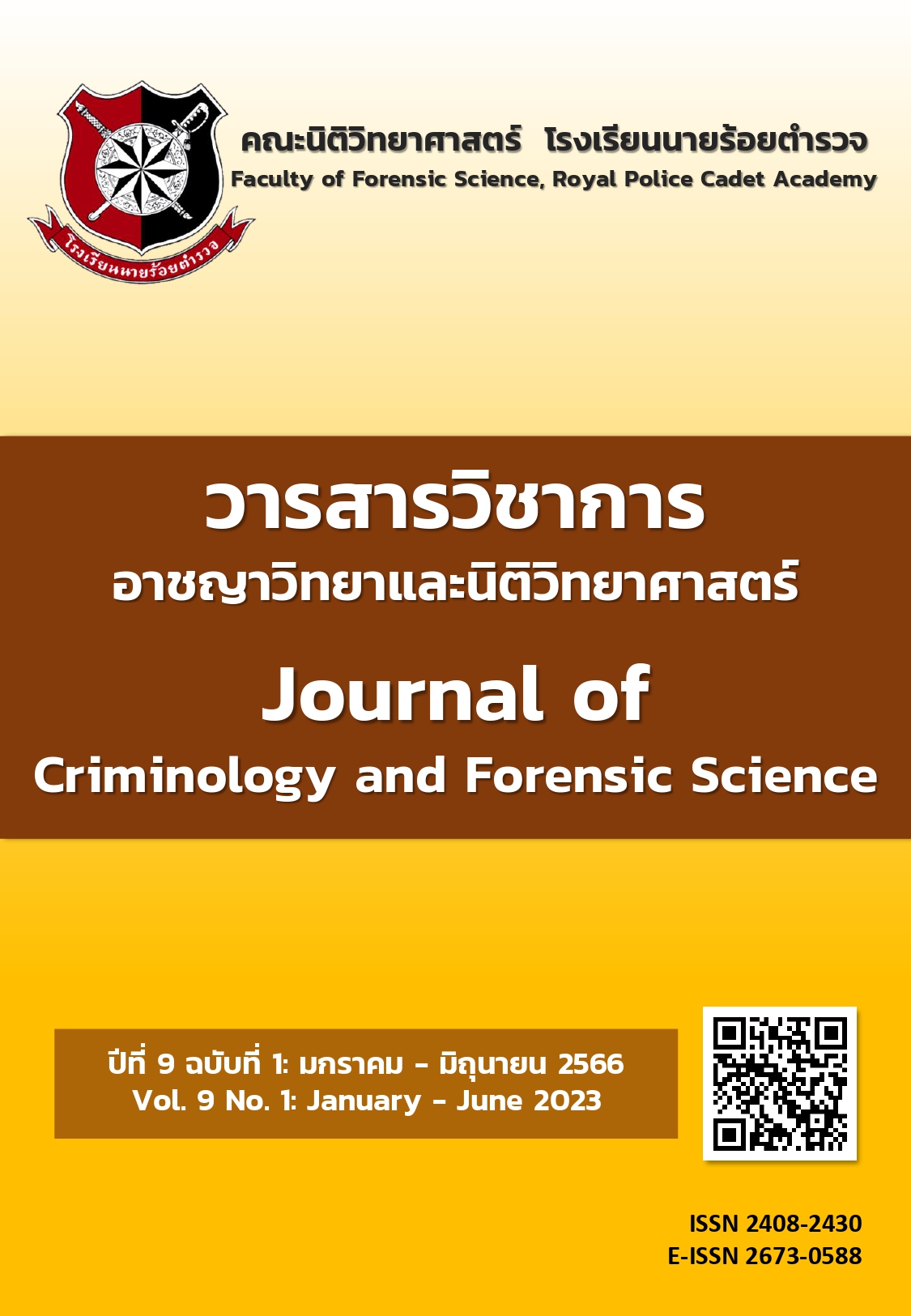ระบาดวิทยาการตรวจพบพืชกระท่อมและกัญชาในเลือดจากการชันสูตรศพทางนิติเวช ภาควิชานิติเวชศาสตร์ จุฬาลงกรณ์มหาวิทยาลัย ก่อนและหลังเปลี่ยนแปลงกฎหมายยาเสพติดที่เกี่ยวข้องในประเทศไทย
Main Article Content
บทคัดย่อ
พืชกระท่อมและกัญชาเป็นสารออกฤทธิ์ต่อจิตประสาทที่ถูกเฝ้าระวังทั้งภายในและต่างประเทศ ในช่วง 4 ปีที่ผ่านมามีการเปลี่ยนแปลงกฎหมายเกี่ยวข้องกับพืชกระท่อมและกัญชา การศึกษานี้มีจุดประสงค์เพื่อศึกษาระบาดวิทยาของการตรวจพบสารออกฤทธิ์จากพืชกระท่อมและกัญชาเปรียบเทียบ 1 ปีก่อนและหลังเปลี่ยนแปลงกฎหมายในพื้นที่กรุงเทพมหานคร โดยกัญชาใช้วันที่ 15 ธันวาคม พ.ศ. 2563 และพืชกระท่อมใช้วันที่ 24 สิงหาคม พ.ศ. 2564 เป็นจุดตัด ข้อมูลที่ใช้วิเคราะห์เป็นรายงานผลตรวจยืนยันสารพิษและสารเสพติดในเลือดทางนิติพิษวิทยาจากศพ ณ ภาควิชานิติเวชศาสตร์ จุฬาลงกรณ์มหาวิทยาลัย ที่มีการชันสูตรพลิกศพ ณ ที่เกิดเหตุในช่วงเวลาดังกล่าว ข้อมูลที่นำมาวิเคราะห์ร่วมได้แก่เพศ อายุ สัญชาติ สาเหตุการเสียชีวิตและสารออกฤทธิ์อื่นที่ใช้ร่วม ผลศึกษาพบแนวโน้มที่เพิ่มขึ้นของการตรวจพบสารออกฤทธิ์จากพืชกระท่อมในศพ ขณะที่แนวโน้มของสารออกฤทธิ์จากกัญชาเพิ่มขึ้นเล็กน้อย เริ่มตรวจพบสารออกฤทธิ์จากพืชกระท่อมก่อนเปลี่ยนแปลงกฎหมาย 7 เดือนในจำนวน 0-5 รายต่อเดือน หลังเปลี่ยนแปลงกฎหมายพบในจำนวนประมาณ 4-11 รายต่อเดือน ในขณะที่เริ่มตรวจพบสารออกฤทธิ์จากกัญชารวมทั้งสิ้น 3 รายในช่วง 12 เดือน แนวโน้มเหล่านี้ควรต้องติดตามอย่างต่อเนื่องเพื่อประโยชน์สำหรับวางแผนป้องกันและควบคุมการใช้ในทางที่ผิด รวมถึงการกำหนดนโยบายในระดับประเทศ
Article Details

อนุญาตภายใต้เงื่อนไข Creative Commons Attribution-NonCommercial-NoDerivatives 4.0 International License.
เนื้อหาและข้อมูลในบทความที่ลงตีพิมพ์ใน วารสารวิชาการอาชญาวิทยาและนิติวิทยาศาสตร์ โรงเรียนนายร้อยตำรวจ ถิอว่าเป็นข้อคิดเห็นและความรั้บผิดชอบของผู้เขียนบทความโดยตรงซึ่งกองบรรณาธิการวารสาร ไม่จำเป็นต้องเห็นด้วยหรือรับผิดชอบใดๆ
บทความ ข้อมูล เนื้อหา รูปภาพ ฯลฯ ที่ได้รับการตีพิมพ์ใน วารสารวิชาการอาชญาวิทยาและนิติวิทยาศาสตร์ ถือว่าเป็นลิขสิทธิ์ของวารสาร วารสารวิชาการอาชญาวิทยาและนิติวิทยาศาสตร์ หากบุคคลหรือหน่วยงานใดต้องการนำทั้งหมดหรือส่วนหนึ่งส่วนใดไปเผยแพร่ต่อหรือเพื่อกระทำการใดๆ จะต้องได้รับอนุญาตเป็นลายลักษณ์อักษรจาก วารสารวิชาการอาชญาวิทยาและนิติวิทยาศาสตร์ ก่อนเท่านั้น
เอกสารอ้างอิง
Bergen-Cico, D., & MacClurg, K. (2016). Kratom (Mitragyna speciosa) use, addiction potential, and legal status. Neuropathology of Drug Addictions and Substance Misuse, 3, 903–911.
Brunet, B., & Mura, P. (2014). Cannabis and drug-facilitated crimes. Toxicological Aspects of Drug-Facilitated Crimes (pp. 139–157). https://doi.org/10.1016/b978-0-12-416748-3.00006-2
Cerdá, M., Mauro, C., Hamilton, A., Levy, N. S., Santaella-Tenorio, J., Hasin, D., Wall, M. M., Keyes, K. M., & Martins, S. S. (2019). Association between recreational marijuana legalization in the United States and changes in marijuana use and cannabis use disorder from 2008 to 2016. JAMA Psychiatry, 77(2), 165–171.
Choi, N. G., Marti, C. N., & DiNitto, D. M. (2019). Changes in post-mortem marijuana-positive toxicologies among youth suicide decedents, 2005–2015. Children and Youth Services Review, 100, 461–467.
Corkery, J. M., Streete, P., Claridge, H., Goodair, C., Papanti, D., Orsolini, L., Schifano, F., Sikka, K., Körber, S., & Hendricks, A. (2019). Characteristics of deaths associated with kratom use. Journal of Psychopharmacology, 33(9), 1102–1123.
European Monitoring Centre for Drugs and Drugs Addiction. (n.d.). Kratom drug profile. Retrieved October 22, 2022. from https://www.emcdda.europa.eu/publications/ drug-profiles/kratom
Farmer, C. M., Monfort, S. S., & Woods, A. N. (2022). Changes in traffic crash rates after legalization of marijuana: results by crash severity. Journal of Studies on Alcohol and Drugs, 83(4), 494–501.
Forensic Drug Addict Monitoring Network. (2022). Report from forensic drug addict monitoring project in 2021 (pp. 35–38, 43–46). Retrieved October 22, 2022. from https://nctc.oncb.go.th/manage/researchMgt/import/researchFull/20220908_140703ONCB.pdf (In Thai)
Jittasopa, W., & Srisont, S. (2021). The causes of death and pathological findings of kratom users. American Journal of Forensic Medicine & Pathology, 42(4), 335–340.
Jordan, A., Sherazi, A., Flewelling, A. J., Northrup, V., Naseemuddin, A., & Shea, J. L. (2022). Identification of cannabinoids in post-mortem blood samples from the province of New Brunswick before and after recreational cannabis legalization. International Journal of Drug Policy, 103, 1–7.
Kratom Act B.E. 2565. (2022, 26 August). Ratchakitchanubeksa. Book 139, Part 52 Kor, pp. 1-14. (In Thai).
Lemos, N. P., & Ingle, E. A. (2011). Cannabinoids in postmortem toxicology. Journal of Analytical Toxicology, 35(7), 394–401.
Ministry of Public Health of Thailand. (2020). Marijuana use recommendation for medical purpose. Retrieved October 22, 2022. from http://cannabis.fda.moph.go.th/wp-content/uploads/PDF/manual/February_2020/Guidance-Updated-v-4_update-20200120-cover.pdf. (In Thai).
Narcotic Act B.E. 2564 No.8. (2021, 26 May). Ratchakitchanubeksa. Book 138, Part 35 Kor, pp. 1-3. (In Thai)
Narongchai, P., Narongchai, S., & Thampituk, S. (2007). The incidence of drug abuse in unnatural deaths in northern Thailand. Journal of the Medical Association of Thailand, 90(1), 137–142.
National Academies of Sciences, Engineering, and Medicine. (2017). The health effects of cannabis and cannabinoids. National Academies Press. Retrieved October 22, 2022. from https://doi.org/10.17226/24625
Notification of the Ministry of Public Health Re: Reference of narcotic drug group 5 B.E. 2563. (2020, 13 December). Ratchakitchanubeksa. Book 137, Special Part 290 Ngor, pp. 33-34. (In Thai)
Notification of the Ministry of Public Health Re: Reference of narcotic drug group 5 B.E. 2565. (2022, 9 Feburary). Ratchakitchanubeksa. Book 139, Special Part 35 Ngor, pp. 8 (In Thai)
Pongchanthuek, S. (1991). Narcotic drug control and rehabilitation. Region 7 Medical Journal, 10(3), 185–191. (In Thai)
Schlaffer, M.Craddock, A., & Collins, J. J. (1997). Fact Sheet: Drug-Related Crime. Bureau of Justice Statistics. Retrieved October 22, 2022. from http://bjs.ojp.gov/content/pub/ pdf/DRRC.PDF.
Smart, R., & Pacula, R. L. (2019). Early evidence of the impact of cannabis legalization on cannabis use, cannabis use disorder, and the use of other substances: Findings from state policy evaluations. The American Journal of Drug and Alcohol Abuse, 45(6), 644–663.
Tangsermkijsakul, A., & Pipatchotitham, T. (2022). Prevalence of commonly abused drugs detected from drug testing in unnatural death cases during 1-year period at Thammasat University Hospital. Asian Medical Journal and Alternative Medicine, 22(1), 40–49.
Tansrisawad, N. (2021). Cannabis in forensic aspect. Revolution in global health. September 8-10, 2021. Faculty of Medicine, Chulalongkorn University, Thailand.
(In Thai)
United Nations. (1996). Final act of the United Nations conference for the adoption of a single convention on narcotic drugs 1961. Retrieved October 22, 2022. from https://www.unodc.org/pdf/convention_1961_en.pdf
United Nations Office on Drugs and Crime. (2022). World drug report 2022. Retrieved October 22, 2022. from https://www.unodc.org/unodc/en/data-and-analysis/world-drug-report-2022.html
Volkow, N. D., Baler, R. D., Compton, W. M., & Weiss, S. R. B. (2014). Adverse health effects of marijuana use. New England Journal of Medicine, 370(23), 2219–2227.
Worasuwannarak, W., Sribanditmongkol, P., Aramrattana, A., Junkuy, A., Chaijaruwanich, J., Kummaraka, U., Kawilapat, S., Homkham, N., Traisathit, P., & Forensic Drug Addict Monitoring Network. (2019). Trends in substance abuse detection in unnatural deaths in Thailand, 2007–2018. ONCB Journal, 35(3), 44–51. (In Thai)
Wu, G., Li, Y., & Lang, X. E. (2022). Effects of recreational marijuana legalization on clearance rates for violent crimes: evidence from Oregon. International Journal of Drug Policy, 100, 1–6.


